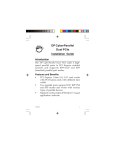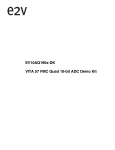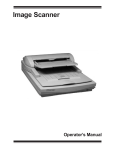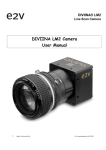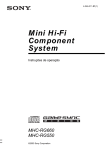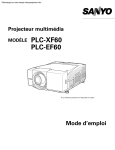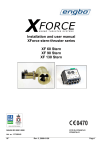Download EV10AQ190-EB Evaluation Board User Guide
Transcript
EV10AQ190-EB Evaluation Board .............................................................................................. User Guide Section 1 Introduction 1.1 Scope The EV10AQ190-EB Evaluation Kit is designed to facilitate the evaluation and characterization of the EV10AQ190 Quad 10-bit 1.25 Gsps ADC in AC coupled mode. The EV10AQ190-EB Evaluation Kit includes: The Quad 10-bit 1.25 Gsps ADC Evaluation Board including EV10AQ190 ADC and Atmel ATMEGA128 AVR soldered A cable for connection to the RS-232 port Software tools necessary to use the SPI The user guide uses the EV10AQ190-EB Evaluation Kit as an evaluation and demonstration platform and provides guidelines for its proper use. 1.2 Description The EV10AQ190-EB Evaluation Board is very straightforward as it implements e2v EV10AQ190 Quad 10-bit 1.25 Gsps ADC device, Atmel ATMEGA128 AVR, SMA connectors for the sampling clock, analog inputs and reset inputs accesses and 2.54 mm pitch connectors compatible with high-speed acquisition system probes. Thanks to its user-friendly interface, the EV10AQ190-EB Kit enables to test all the functions of the EV10AQ190 Quad 10-bit 1.25 Gsps ADC using the SPI connected to a PC. To achieve optimal performance, the EV10AQ190-EB Evaluation Board was designed in a 6-metal-layer board using FR4 HTG epoxy dielectric material (200 µm, ISOLA IS410 featuring a resin content of 45%). The board implements the following devices: The Quad 10-bit 1.25 Gsps ADC Evaluation Board with the EV10AQ190 ADC soldered SMA connectors for CLK, CLKN, AAI, AAIN, BAI, BAIN, CAI, CAIN, DAI, DAIN, SYNCP, SYNCN, CAL, CALN signals 2.54 mm pitch connectors for the digital outputs, compatible with high-speed acquisition system probes Banana jacks for the power supply accesses, the die junction temperature monitoring functions, reference resistor, analog input common mode voltage (2 mm) An RS-232 connector for PC interface EV10AQ190-EB - User Guide 1-3 0964A–BDC–12/08 e2v semiconductors SAS 2008 Introduction The board dimensions are 170 mm x 185 mm. The board comes fully assembled and tested, with the EV10AQ190 installed. Figure 1-1. EV10AQ190-EB Evaluation Board Simplified Schematic RS232 3.3V GND Res62 Res50 CLKN CLK SYNCP SYNCN DiodC DiodA CALN CAL CAL CALN C H P O R T C L P O R T B L B H P O R T P O R T A L A H P O R T P O R T EV10AQ190 D H D L P O R T P O R T VCCD GND DAIN DAI CAIN CAI BAIN BAI AAIN AAI VCC VCCO GND GND CMIREFCD CMIREFAB As shown in Figure 1-1, different power supplies are required: VCC = 3.3V analog positive power supply (includes the SPI pads) VCCD = 1.8V digital positive power supply VCCO = 1.8V output power supply 3.3V digital interface primary power supply for the microcontroller 1-4 0964A–BDC–12/08 e2v semiconductors SAS 2008 EV10AQ190-EB - User Guide Section 2 Hardware Description 2.1 Board Structure In order to achieve optimum full-speed operation of the EV10AQ190 Quad 10-bit 1.25 Gsps ADC, a multilayer board structure was retained for the evaluation board. Six copper layers are used, dedicated to the signal traces, ground planes and power supply planes. The board is made in FR4 HTG epoxy dielectric material (ISOLA IS410). Table 2-1 gives a detailed description of the board's structure. Table 2-1. Board Layer Thickness Profile Layer Characteristics Layer 1 Copper layer Copper thickness = 40 µm (with NiAu finish) AC signals traces = 50Ω microstrip lines DC signals traces FR4 HTG/dielectric layer Layer thickness = 200 µm Layer 2 Copper layer Copper thickness = 18 µm Upper ground plane = reference plane FR4 HTG/dielectric layer Layer thickness = 349 µm Layer 3 Copper layer Copper thickness = 18 µm Power plane = VCC FR4 HTG/dielectric layer Layer thickness = 350 µm Layer 4 Copper layer Copper thickness = 18 µm Power planes = VCCD’ VCCO and 3V3 FR4 HTG/dielectric layer Layer thickness = 350 µm Layer 5 Copper layer Copper thickness = 18 µm Power planes = reference plane (identical to layer 3) FR4 HTG/dielectric layer Layer thickness = 200 µm Layer 6 Copper layer Copper thickness = 40 µm (with NiAu finish) AC signals traces = 50Ω microstrip lines DC signals traces EV10AQ190-EB - User Guide 2-5 0964A–BDC–12/08 e2v semiconductors SAS 2008 Hardware Description The board is 1.6 mm thick. The clock, analog inputs, resets, digital data output signals and ADC functions occupy the top metal layer while the SPI signals and circuitry occupy the bottom layer. The ground planes occupy layer 2 and 5. Layer 3 and 4 are dedicated to the power supplies. 2.2 Analog Inputs/Clock Input The differential clock and analog inputs are provided by SMA connectors (reference: VITELEC 142-0701-8511). Both pairs are AC coupled using 10 nF capacitors. Special care was taken for the routing of the analog and clock input signals for optimum performance in the high-frequency domain: 50Ω lines matched to ±0.1 mm (in length) between XAI and XAIN (X = A, B, C or D) or CLK and CLKN 909 µm pitch between the differential traces 1270 µm between two differential pairs 361 µm line width 40 µm thickness 850 µm diameter hole in the ground layer below the XAI and XAIN or CLK and CLKN ball footprints Figure 2-1. Board Layout for the Differential Analog and Clock Inputs e = 40 µm 361 µm 909 µm 361 µm 200 µm FR4 HTG 1270 µm Note: 2.3 Digital Output The analog inputs and clock inputs are AC coupled with 10 nF very close to the SMA connectors. The digital output lines were designed with the following recommendations: 50Ω lines matched to ±2.5 mm (in length) between signal of the same differential pair ±1mm line length difference between signals of two differential pairs 635 µm pitch between the differential traces 650 µm between two differential pairs 310 µm line width 40 µm thickness 2-6 0964A–BDC–12/08 e2v semiconductors SAS 2008 EV10AQ190-EB - User Guide Hardware Description Figure 2-2. Board Layout for the Differential Digital Outputs e = 40 µm 310 µm 325 µm 310 µm 650 µm FR4 HTG 200 µm 635 µm The digital outputs are compatible with LVDS standard. They are on-board 100Ω differentially terminated as described in Figure 2-3. Figure 2-3. Differential Digital Outputs Implementation Connector ADC 100Ω Double row 2.54 mm pitch connectors are used for the digital output data. The upper row is connected to the signal while the lower row is connected to ground, as illustrated in Figure 2-4. Figure 2-4. Differential Digital Outputs 2.54 mm Pitch Connector (X = A, B, C or D) 2.4 Reset Inputs XDR XDRN XD0 XD0N XD7 XD7N XORN XOR N GND GND GND GND GND GND GND GND Two hardware reset signals are provided: – SYNCP, SYNCN corresponds to the reset of the output clock of the ADC (analog reset). – RSTN corresponds to the reset of the SPI (makes the SPI registers go to their default value). The differential reset inputs SYNC, SYNCN are provided by SMA connectors (reference: VITELEC 142-0701-8511).The signals are AC coupled using 10 nF capacitors and pulled up and down via 200Ω resistors. A variable resistor of 500Ω is implemented on SYNC: by adjusting this resistor value one can activate and deactivate easily the reset signal. EV10AQ190-EB - User Guide 2-7 0964A–BDC–12/08 e2v semiconductors SAS 2008 Hardware Description 50Ω lines matched to ±0.1 mm (in length) between SYNCP and SYNCN 909 µm pitch between the differential traces 1270 µm between two differential pairs 361 µm line width 40 µm thickness Figure 2-5. Board Layout for the SYNC Signal e = 40 µm 361 µm 361 µm 909 µm 200 µm FR4 HTG 1270 µm Figure 2-6. SYNC, SYNCN Inputs Implementation 3.3V 10 nF 500Ω SYNC SYNC (AC11) 200Ω 3.3V EV10AQ190 GND 200 Ω SYNCN SYNCN (AD11) 10 nF 200 Ω GND A push button is provided for the RSTN reset, as described in Figure 2-7 on page 9. This reset can also be generated through the AVR (via the User Interface). 2-8 0964A–BDC–12/08 e2v semiconductors SAS 2008 EV10AQ190-EB - User Guide Hardware Description Figure 2-7. RSTN Input Implementation 3.3V 10KΩ RSTN (AC15) EV10AQ190 0Ω 0Ω To AVR GND 2.5 Power Supplies Layers 3 and 4 are dedicated to power supply planes (VCC, VCCD, VCCO and 3.3V). The supply traces are low impedance and are surrounded by two ground planes (layer 2 and 5). Each incoming power supply is bypassed at the banana jack by a 1 µF Tantalum capacitor in parallel with a 100 nF chip capacitor. Each power supply is decoupled as close as possible to the EV10AQ190 device by 10 nF in parallel with 100 pF surface mount chip capacitors. Note: EV10AQ190-EB - User Guide The decoupling capacitors are superimposed with the 100 pF capacitor mounted first. 2-9 0964A–BDC–12/08 e2v semiconductors SAS 2008 Hardware Description 2-10 0964A–BDC–12/08 e2v semiconductors SAS 2008 EV10AQ190-EB - User Guide Section 3 Operating Characteristics 3.1 Introduction This section describes a typical configuration for operating the evaluation board of the EV10AQ190 Quad 10-bit 1.25 Gsps ADC. The analog input signals and the sampling clock signal should be accessed in a differential fashion. Band pass filters should also be used to optimize the performance of the ADC both on the analog input and on the clock. It is necessary to use a very low jitter source for the clock signal (recommended maximum jitter = 50 ps). Note: 3.2 Operating Procedure The analog inputs and clock are AC coupled on the board. 1. Install the SPI software as described in section 4 Software Tools. 2. Connect the power supplies and ground accesses through the dedicated banana jacks. VCC = 3.3V, VCCD = 1.8V, VCCO = 1.8V and 3.3V. 3. Connect the clock input signals. Use a very low-phase noise high- frequency generator as well as a band pass filter to optimize the clock performance. The clock input level is typically 3 dBm and should not exceed 10 dBm (into 50Ω). The clock frequency should be set to 2.5 GHz (corresponding to 1.25 Gsps sampling in 4-channel mode or 2.5 Gsps sampling in 2-channel mode or 5 Gsps sampling in 1-channel mode). 4. Connect the analog input signals (the board has been designed to allow only AC coupled analog inputs). Use a low-phase noise high-frequency generator as well as a band pass filter to optimize the analog input performance. The analog input full scale is 500 mV peak-to-peak around zero (analog input providing the Input common mode). It is recommended to use the ADC with an input signal of –1 dBFS max (to avoid saturation of the ADC). 5. Connect the high-speed acquisition system probes to the output connectors. The digital data are differentially terminated on-board (100Ω) however, they can be probed either in differential or in single-ended mode. 6. Connect the PC's RS-232 connector to the evaluation board's serial interface. 7. Switch on the ADC power supplies (recommended power up sequence: simultaneous or in the following order: VCC = 3.3V, VCCD = 1.8V, VCCO = 1.8V and 3.3V). 8. Turn on the RF clock generator. 9. Turn on the RF signal generator. EV10AQ190-EB - User Guide 3-11 0964A–BDC–12/08 e2v semiconductors SAS 2008 Operating Characteristics 10. Perform an analog reset (SYNC potentiometer) on the device. 11. Launch Quad-10bit.exe software. The EV10AQ190-EB evaluation board is now ready for operation. 3.3 Electrical Characteristics For more information, please refer to the device datasheet. Table 3-1. Recommended Conditions of Use Parameter Symbol Comments Recommended Unit Positive supply voltage VCC Includes SPI pads 3.3 V Positive digital supply voltage VCCD SPI core 1.8 V Positive output supply voltage VCCO Output buffers 1.8 V Differential analog input voltage (Full Scale) VIN, VINN VIN -VINN ±250 500 mV mVpp Digital CMOS input VD 0 VCC V Clock input power level PCLK PCLKN 0 dBm 2.5 GHz –55 to 150 °C Clock frequency FCLK Storage temperature Tstg VIL VIH For operation at 1.25 Gsps, 2.5 Gsps or 5 Gsps in 4-channel, 2-channel or 1-channel mode respectively Typical conditions: VCC = 3.3V, VCCD = 1.8V, VCCO = 1.8V VIN -VINN = 500 mVpp full scale differential input, digital outputs LVDS (100Ω) Tamb (typical) = 25°C unless otherwise specified 3-12 0964A–BDC–12/08 e2v semiconductors SAS 2008 EV10AQ190-EB - User Guide Operating Characteristics Table 3-2. Electrical Characteristics Parameter Symbol Test Level Min Resolution Typ Max 10 Unit Bit Power Requirements Power supply voltage Analog and SPI pads Digital Output VCC VCCD VCCO Power supply current Analog and SPI pads Digital Output ICC ICCD ICCO 1.6 202 3 A mA mA Power supply current (Partial standby mode AB) Analog and SPI pads Digital Output ICC ICCD ICCO 884 114 3 mA mA mA Power supply current (Partial standby mode CD) Analog and SPI pads Digital Output ICC ICCD ICCO 899 109 3 mA mA mA Power supply current (full standby mode) Analog and SPI pads Digital Output ICC ICCD ICCO 188 23 3 mA mA mA 5.64 3.12 3.16 0.66 W W W Power dissipation Default mode Partial standby mode (AB) Partial standby mode (CD) Full standby mode EV10AQ190-EB - User Guide PD 3.15 1.7 1.7 3.3 1.8 1.8 3.45 1.9 1.9 V V V 3-13 0964A–BDC–12/08 e2v semiconductors SAS 2008 Operating Characteristics 3-14 0964A–BDC–12/08 e2v semiconductors SAS 2008 EV10AQ190-EB - User Guide Section 4 Software Tools 4.1 Overview The Quad 10-bit 1.25 Gsps ADC Evaluation user interface software is a Visual C++® compiled graphical interface that does not require a licence to run on a Windows® NT® and Windows® 2000/98/XP® PC. The software uses intuitive push-buttons and pop-up menus to write data from the hardware. 4.2 Configuration The advised configuration for Windows® 98 is: PC with Intel® Pentium®Microprocessor of over 100 MHz Memory of at least 24 Mo For other versions of Windows ® OS, use the recommended configuration from Microsoft. Note: EV10AQ190-EB - User Guide Two COM ports are necessary to use two boards simultaneously. 4-15 0964A–BDC–12/08 e2v semiconductors SAS 2008 Software Tools 4.3 Getting Started 1. Install the ADC Quad 10-bit application on your computer by launching the Setup_Quad-10bit.exe installer (please refer to the latest version available). Figure 4-1. Install Window The screen shown in Figure 4-2 is displayed. Figure 4-2. QUAD 10-bit 1.25 Gsps Application Setup wizard Window 4-16 0964A–BDC–12/08 e2v semiconductors SAS 2008 EV10AQ190-EB - User Guide Software Tools 2. Select Destination Directory Figure 4-3. QUAD 10-bit 1.25 Gsps Select Destination Directory Window 3. Select Start Menu Folder Figure 4-4. QUAD 10-bit 1.25 Gsps Select Start Menu Window EV10AQ190-EB - User Guide 4-17 0964A–BDC–12/08 e2v semiconductors SAS 2008 Software Tools 4. Ready to install Figure 4-5. QUAD 10-bit 1.25 Gsps Ready To Install Window If you agree with the install configuration, press Install button. Figure 4-6. QUAD 10-bit 1.25 Gsps Application Setup Install Push Button The installation of the software is now complete. 4-18 0964A–BDC–12/08 e2v semiconductors SAS 2008 EV10AQ190-EB - User Guide Software Tools Figure 4-7. QUAD 10-bit 1.25 Gsps Completing Setup Wizard Window After the installation, you can launch the interface with the following file: C:\Program Files\e2v\QUAD_10bit\Quad ADC 10bit.exe The window shown in Figure 4-8 will be displayed. EV10AQ190-EB - User Guide 4-19 0964A–BDC–12/08 e2v semiconductors SAS 2008 Software Tools Figure 4-8. QUAD 10-bit 1.25 Gsps User Interface Window Notes: 4-20 0964A–BDC–12/08 e2v semiconductors SAS 2008 1. If the QUAD 10-bit 1.25 Gsps application board is not connected or not powered, a red LED appears on the right of the reset button and the application is grayed out. 2. Check your connection and restart the application. 3. If the serial interface is not active the LED appears in orange and the application is grayed out. EV10AQ190-EB - User Guide Software Tools Figure 4-9. QUAD 10-bit 1.25 Gsps User Interface Window Switch ON power supplies and launch the Quad ADC 10bit.exe, the application should become available and the LED turns to green. Figure 4-10. QUAD 10-bit 1.25 Gsps User Interface Window 4.4 Troubleshooting 1. check that you own rights to write in the directory. 2. check for the available disk space. 3. check that at least one RS-232 serial port is free and properly configured. 4. check that the serial port and DB9 connector are properly connected. 5. check that all supplies are properly powered on. The serial port configuration should be as follows: Bit rate: 19200 Data coding: 8 bits 1 start bit, 1 stop bit No parity check Figure 4-11. QUAD 10-bit 1.25 Gsps User Interface Hardware Implementation PC Evaluation Board Software ADC Quad 10-bit Serial port 1. Use an RS-232 port to send data to the ADC. 2. Connect the crossed DB9 (F/F) cable between your PC and your evaluation board as illustrated in Figure 4.12. EV10AQ190-EB - User Guide 4-21 0964A–BDC–12/08 e2v semiconductors SAS 2008 Software Tools Figure 4-12. Crossed Cable DB 9 Female 4.5 Installation Software 2 2 3 3 5 5 DB 9 Female At startup, the application automatically checks all RS232 ports available on the computer and tries to find the evaluation board connected to the RS232 port. Figure 4-13. QUAD 10-bit 1.25 Gsps User Interface Port Menu The Port menu shows all available ports on your computer. The port currently used has a check mark on its left. By clicking another port item the application will try to connect to an evaluation board via the selected port. If a board is successfully detected on the new port, the LED is green and the new port gets the check mark. If the application is not able to find a board on this port, an error message is displayed. 4-22 0964A–BDC–12/08 e2v semiconductors SAS 2008 EV10AQ190-EB - User Guide Software Tools 4.6 Operating Modes The Quad ADC software included with the evaluation board provides a graphical user interface to configure the ADC. Push buttons, popup menus and capture windows allows easy: 1. Settings. 2. Test mode. 3. Gain/Offset/Phase adjustments. With Setting and Test mode windows always click on Apply button to validate any command. Clicking the Cancel button will restore last settings sent with Apply button. With Gain/Offset/Phase and INL windows always click on Write then Send buttons to validate any command. Reset button allows reconfiguring ADC to Default Mode. or 4.6.1 Settings EV10AQ190-EB - User Guide 4-23 0964A–BDC–12/08 e2v semiconductors SAS 2008 Software Tools Figure 4-14. Settings In this window, five functions are available: ADC mode: – 4-channel mode = the four ADCs work independently at Fclock/2 sampling rate (where Fclock is the external clock signal frequency). 4-24 0964A–BDC–12/08 e2v semiconductors SAS 2008 EV10AQ190-EB - User Guide Software Tools – Two-channel mode = the four ADCs are interleaved two by two (A and B, C and D), the sampling rate is equal to Fclock (where Fclock is the external clock signal frequency), the analog inputs can be applied to A or B and respectively C or D. Figure 4-15. Two-channel Mode – One-channel mode = the four ADCs are all interleaved, the sampling rate is Fclock x 2 (where Fclock is the external clock signal frequency), the analog input can be applied to either A, B, C or D channel. Figure 4-16. One-channel Mode EV10AQ190-EB - User Guide 4-25 0964A–BDC–12/08 e2v semiconductors SAS 2008 Software Tools Standby mode – No standby = all channels are active (A: ON, B: ON, C: ON, D: ON). – Partial standby = either A and B are in standby or C and D are in standby. – Full standby = all four ADCs are in standby. 4-26 0964A–BDC–12/08 e2v semiconductors SAS 2008 EV10AQ190-EB - User Guide Software Tools – Full standby = all 4 ADCs are in standby General settings – Output mode = Gray coding or binary coding – Bandwidth selection = nominal or full band at –3 dB Synchronization: programs the number of clock cycles prior to output clock restart after SYNC reset EV10AQ190-EB - User Guide 4-27 0964A–BDC–12/08 e2v semiconductors SAS 2008 Software Tools – Software reset = resets the SPI by software 4.6.2 Test In this window, the test mode is available: – Either a ramp is generated within each ADC and output – Or a flashing bit at 1 is output on each ADC (1 FF pattern every ten 00 patterns) 4-28 0964A–BDC–12/08 e2v semiconductors SAS 2008 EV10AQ190-EB - User Guide Software Tools 4.6.3 Gain/Offset/Phase In this window, you can adjust the gain, offset and phase of the channel selected via the channel select button on the top right of the user interface. A LED shows if the channel is ON (active, green LED) or OFF (not active, red LED) and if the same channel is ready (ready to receive gain, offset or phase orders, green LED) or busy (not ready to receive new calibration orders, red LED). Once a channel has been selected, you can adjust the gain/offset/phase of this channel: – You first need to enter the desired value for the gain/offset/phase thanks to the cursor. – If you need to retrieve the old value of the gain/offset/phase click CANCEL. – Then you should WRITE this value to the internal registers by clicking on the WRITE button. – If several adjustments are needed (gain AND offset AND phase), then select each value and then click on the respective WRITE buttons. – Once all adjustments are made via the WRITE buttons, then you can SEND the orders to the ADC SPI via the SEND button. EV10AQ190-EB - User Guide 4-29 0964A–BDC–12/08 e2v semiconductors SAS 2008 Software Tools – The calibration is successful if the internal gain/offset/phase boxes display the entered values. If a new value for the gain/offset/phase has been entered by mistake, it is possible to retrieve the initial value by pushing the CANCEL button. The general Apply and Cancel general buttons are not active in this window (as soon as the Send button is pressed, the gain/offset/phase adjustments are made active). 4-30 0964A–BDC–12/08 e2v semiconductors SAS 2008 EV10AQ190-EB - User Guide Software Tools In the following example, channel A is selected. Values for the gain, the offset and the phase have been entered via the Write and then the Send buttons, which explains why the Internal values are equal to the settings values. In the following example, you can see that the internal phase register is set to 0.015 and that the user wants the phase to be set to -15 ps. In the second picture, the Write and Send buttons have been pushed and the internal register shows the new entered value for the phase. EV10AQ190-EB - User Guide 4-31 0964A–BDC–12/08 e2v semiconductors SAS 2008 Software Tools 4.6.4 Input Impedance In this window, it is possible to re-adjust the internal input resistor, which should be matched to 50. The procedure is similar to the previous ones: – Select the channel where you need to adjust the input impedance – Check that the channel is ON and Ready (green LEDs) – Enter the resistor value – Push the Write button to write these values to the internal registers (you can retrieve the initial value of the impedance by clicking on the Cancel button). This function helps to re-adjust the input impedance in case of a slight mismatch due to temperature variations or process variations. 4-32 0964A–BDC–12/08 e2v semiconductors SAS 2008 EV10AQ190-EB - User Guide Software Tools 4.6.5 Load and Save configuration The File menu shows possibility to load or save a configuration of the EV10AQ190 or to create a data-log file. It is possible to save the configuration of EV10AQ190 into a .txt file: Select the File menu and click to Save Configuration. Example of configuration file EV10AQ190-EB - User Guide 4-33 0964A–BDC–12/08 e2v semiconductors SAS 2008 Software Tools This file could be loaded into the EV10AQ190. 1. Select the File menu and click to Load Configuration chose the xx.txt file. 2. It is possible to save the Data-log of the EV10AQ190 configuration into a .txt file. 3. Select the File menu and click to Datalog. 4-34 0964A–BDC–12/08 e2v semiconductors SAS 2008 EV10AQ190-EB - User Guide Software Tools Example of Datalog file: EV10AQ190-EB - User Guide 4-35 0964A–BDC–12/08 e2v semiconductors SAS 2008 Software Tools 4-36 0964A–BDC–12/08 e2v semiconductors SAS 2008 EV10AQ190-EB - User Guide Section 5 Application Information 5.1 Analog Input The analog input (XAI, XAIN) are entered in differential AC coupled mode as described in Figure 5-1. It is recommended to use a differential source to drive the analog inputs of this ADC (external balun or differential amplifier). Note: References of differential amplifiers and external baluns: M/A-COM H9 balun M/A-COM TP101 1:1 transformer In order to optimize the performance of the ADC, it is also recommended to use a band pass filter on the analog input path. Figure 5-1. Differential Analog or Clock Inputs Implementation 10 nF XAI XAI EV10AQ190 XAIN XAIN 10 nF EV10AQ190-EB - User Guide 5-37 0964A–BDC–12/08 e2v semiconductors SAS 2008 Application Information 5.2 Clock Input The clock input can be entered indifferently in single-ended or differential mode with no performance degradation. The clock is AC coupled via 10 nF capacitors as described in Figure 5-2. Figure 5-2. Clock Input Implementation 10 nF CLKI CLKI EV10AQ190 CLKIN CLKIN 10 nF If used in single-ended mode, CLKIN should be terminated to ground via a 50Ω resistor. This is physically done by shorting the SMA on CLKIN with a 50Ω cap. The jitter performance on the clock is crucial to obtain optimum performance from the ADC. We thus recommend to use a very low phase noise clock and to filter the clock signal if a fixed frequency is used. For a clock at 500 MHz, we use in our testbench: Pass band filter from LORCH MICROWAVE 9BP8-500/30-S (up to 8 dB attenuation, 70 dB rejection up to 5000 MHz) 500-14512 500 MHz-SC Sprinter Crystal Oscillator from WENZEL Associates 5.3 Reset input The SYNCP, SYNCN is necessary to start the ADC after power up. The reset signal is implemented as illustrated in Figure 5-3. Figure 5-3. SYNCP, SYNCN Inputs Implementation 3.3V SMA 500Ω 10 nF Test Point SYNC SYNC (AC11) 200Ω 3.3V GND EV10 AQ190 200Ω SYNCN (AD11) SYNCN SMA 200Ω 10 nF Test Point GND By turning the potentiometer on the SYNC signal to the 3.3V, you activate the reset and de-activate it by turning the potentiometer back to its initial position (near ground). 5-38 0964A–BDC–12/08 e2v semiconductors SAS 2008 EV10AQ190-EB - User Guide Application Information 5.4 Output Data The output data are LVDS and are 100Ω terminated to ground as shown in Figure 5-4. Figure 5-4. Output Data on-board Implementation Connector ADC 100Ω The data are output in binary format and in double data rate (the output clock frequency is half the data rate and thus half the input clock frequency). 5.5 5.6 CMIRefAB and CMIRefCD Output Signals Two 2 mm banana jacks are provided for the CMIRefAB and CMIRefCD signals which provides the analog input common mode voltages (= 1.6V). Diode for Junction Temperature Monitoring Two 2 mm banana jacks are provided for the die junction temperature monitoring of the ADC. As the analog input is entered in AC coupled mode, these CMIRefAB and CMIRefCD signals do not need to be used. One banana jack is labeled DIODA and should be applied a current of up to 1 mA (via a multimeter used in current source mode) and the second one is connected to DIODC. The ADC diode is protected via 2 x 3 head-to-tail diodes. Figure 5-5 describes the setup for the die junction temperature monitoring using a multimeter. Figure 5-5. Die Temperature Monitoring Test Setup Protection Diodes DIODA To DIODA V Banana Jacks 1 mA To DIODC DIODC EV10AQ190-EB - User Guide 5-39 0964A–BDC–12/08 e2v semiconductors SAS 2008 Application Information 5.7 Test Bench Description Figure 5-6. Test Bench Description Band pass filter Filter Input Signal Generator 10 MHz synchronisation Thermal system Temperature range -80 to +163˚ AAIN Balun Evaluation Board AAI Quad ADC 10-bit Digital Acquisition System Clock Signal Generator Supply Computer GPIB 5-40 0964A–BDC–12/08 e2v semiconductors SAS 2008 EV10AQ190-EB - User Guide Section 6 Ordering Information 6.1 Ordering Information Table 6-1. Ordering Information Part Number Package Temperature Range Screening Level EV10AQ190CTPY EBGA 380 RoHS Ambient Standard EV10AQ190TPY-EB EBGA 380 RoHS Ambient Prototype EV10AQ190-EB - User Guide Comments Evaluation board 6-41 0964A–BDC–12/08 e2v semiconductors SAS 2008 Ordering Information 6-42 0964A–BDC–12/08 e2v semiconductors SAS 2008 EV10AQ190-EB - User Guide Section 7 Appendices 7.1 EV10AQ190-EB Electrical Schematics Figure 7-1. Power Supplies Bypassing EV10AQ190-EB - User Guide 7-43 0964A–BDC–12/08 e2v semiconductors SAS 2008 Appendices Figure 7-2. Power Supplies Decoupling (J = ± 5% Tolerance) 7-44 0964A–BDC–12/08 e2v semiconductors SAS 2008 EV10AQ190-EB - User Guide Appendices Figure 7-3. Electrical Schematics (AVR) EV10AQ190-EB - User Guide 7-45 0964A–BDC–12/08 e2v semiconductors SAS 2008 Appendices Figure 7-4. Electrical Schematics (ADC) 7-46 0964A–BDC–12/08 e2v semiconductors SAS 2008 EV10AQ190-EB - User Guide Appendices 7.2 EV10AQ190-EB Board Layers Figure 7-5. Top Layer EV10AQ190-EB - User Guide 7-47 0964A–BDC–12/08 e2v semiconductors SAS 2008 Appendices Figure 7-6. Bottom Layer 7-48 0964A–BDC–12/08 e2v semiconductors SAS 2008 EV10AQ190-EB - User Guide Appendices Figure 7-7. Equipped Board (Top) EV10AQ190-EB - User Guide 7-49 0964A–BDC–12/08 e2v semiconductors SAS 2008 Appendices Figure 7-8. Equipped Board (Bottom) 7-50 0964A–BDC–12/08 e2v semiconductors SAS 2008 EV10AQ190-EB - User Guide Table of Contents Section 1 1.1 1.2 Scope........................................................................................................1-3 Description ................................................................................................1-3 Section 2 2.1 2.2 2.3 2.4 2.5 Board Structure .........................................................................................2-5 Analog Inputs/Clock Input .........................................................................2-6 Digital Output ............................................................................................2-6 Reset Inputs..............................................................................................2-7 Power Supplies .........................................................................................2-9 Section 3 3.1 3.2 3.3 Introduction .............................................................................................3-11 Operating Procedure...............................................................................3-11 Electrical Characteristics.........................................................................3-12 Section 4 4.1 4.2 4.3 4.4 4.5 4.6 Overview .................................................................................................4-15 Configuration...........................................................................................4-15 Getting Started........................................................................................4-16 Troubleshooting ......................................................................................4-21 Installation Software................................................................................4-22 Operating Modes ....................................................................................4-23 4.6.1 Settings.............................................................................................4-24 4.6.2 Test...................................................................................................4-28 4.6.3 Gain/Offset/Phase ............................................................................4-29 4.6.4 Input Impedance...............................................................................4-32 4.6.5 Load and Save configuration............................................................4-33 Section 5 5.1 5.2 5.3 5.4 5.5 5.6 5.7 Analog Input............................................................................................5-37 Clock Input ..............................................................................................5-38 Reset input ..............................................................................................5-38 Output Data.............................................................................................5-39 CMIRefAB and CMIRefCD Output Signals .............................................5-39 Diode for Junction Temperature Monitoring............................................5-39 Test Bench Description ...........................................................................5-40 Section 6 6.1 EV10AQ190-EB - User Guide Ordering Information ...............................................................................6-41 iii 0964A–BDC–12/08 e2v semiconductors SAS 2008 Section 7 7.1 7.2 iv 0964A–BDC–12/08 e2v semiconductors SAS 2008 EV10AQ190-EB Electrical Schematics ...................................................7-43 EV10AQ190-EB Board Layers................................................................7-47 EV10AQ190-EB - User Guide How to reach us Home page: www.e2v.com Sales offices: Americas Europe Regional sales office e2v inc e2v ltd 4 Westchester Plaza 106 Waterhouse Lane Elmsford Chelmsford NY 10523-1482 Essex CM1 2QU USA England Tel: +1 (914) 592 6050 or Tel: +44 (0)1245 493493 1-800-342-5338, Fax:: +44 (0)1245 492492 Fax:: +1 (914) 592-5148 mailto: [email protected] mailto: [email protected] Europe Regional sales office Asia Pacific e2v sas e2v ltd 16 Burospace 11/F., F-91572 Bièvres Onfem Tower, Cedex 29 Wyndham Street,Central, France Hong Kong Tel: +33 (0) 16019 5500 Fax: +33 (0) 16019 5529 mailto: [email protected] Europe Regional sales office e2v gmbh Industriestraße 29 82194 Gröbenzell Germany Tel: +49 (0) 8142 41057-0 Fax:: +49 (0) 8142 284547 mailto: [email protected] Tel: +852 3679 364 8/9 Fax: +852 3583 1084 mailto: [email protected] Product Contact: e2v Avenue de Rochepleine BP 123 - 38521 Saint-Egrève Cedex France Tel: +33 (0)4 76 58 30 00 Hotline: mailto: [email protected] Whilst e2v has taken care to ensure the accuracy of the information contained herein it accepts no responsibility for the consequences of any use thereof and also reserves the right to change the specification of goods without notice. e2v accepts no liability beyond that set out in its standard conditions of sale in respect of infringement of third party patents arising from the use of tubes or other devices in accordance with information contained herein. e2v semiconductors SAS 2008 0834D–BDC–12/08 vi 0834D–BDC–12/08 e2v semiconductors SAS 2007






















































